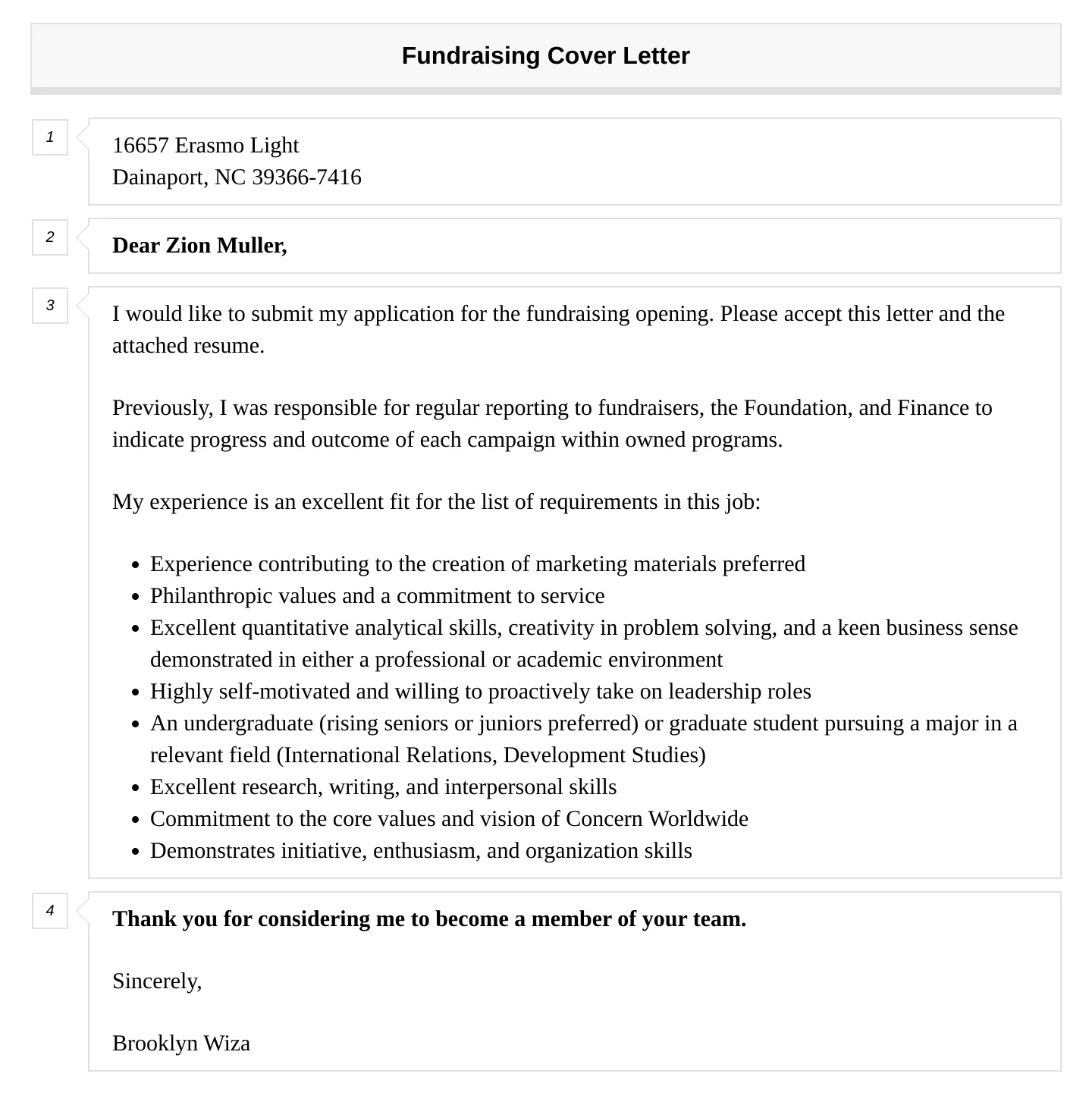Crafting a Fundraising Job Cover Letter That Stands Out
A well-crafted fundraising job cover letter is your first impression, acting as a critical gateway to landing your dream job. It’s more than just a formality; it’s your chance to showcase your passion, skills, and understanding of the nonprofit sector. This guide will provide you with the necessary tools and insights to create a compelling cover letter that grabs the attention of hiring managers and sets you apart from the competition. Remember, in a competitive job market, every detail matters. By following these guidelines, you will significantly increase your chances of securing an interview and ultimately, the fundraising position you desire. A standout cover letter demonstrates your genuine interest in the organization and your ability to contribute meaningfully to their mission.
Understanding the Fundraising Landscape
Before you start writing, understanding the fundraising landscape is crucial. This involves recognizing the various types of fundraising, such as grant writing, major gifts, annual campaigns, and online giving. It also entails being aware of current trends, such as the increasing importance of digital fundraising and donor retention strategies. Knowing the common challenges faced by nonprofits, like budget constraints and competition for funding, is also essential. Demonstrating this understanding in your cover letter shows that you are not just looking for a job, but are genuinely invested in the sector. Research recent successful fundraising campaigns and the strategies employed. Familiarize yourself with the organization’s current fundraising efforts by reviewing their website and annual reports. Understanding the organization’s mission, values, and target audience is also very crucial before starting writing the cover letter.
Key Skills and Qualifications for Fundraising
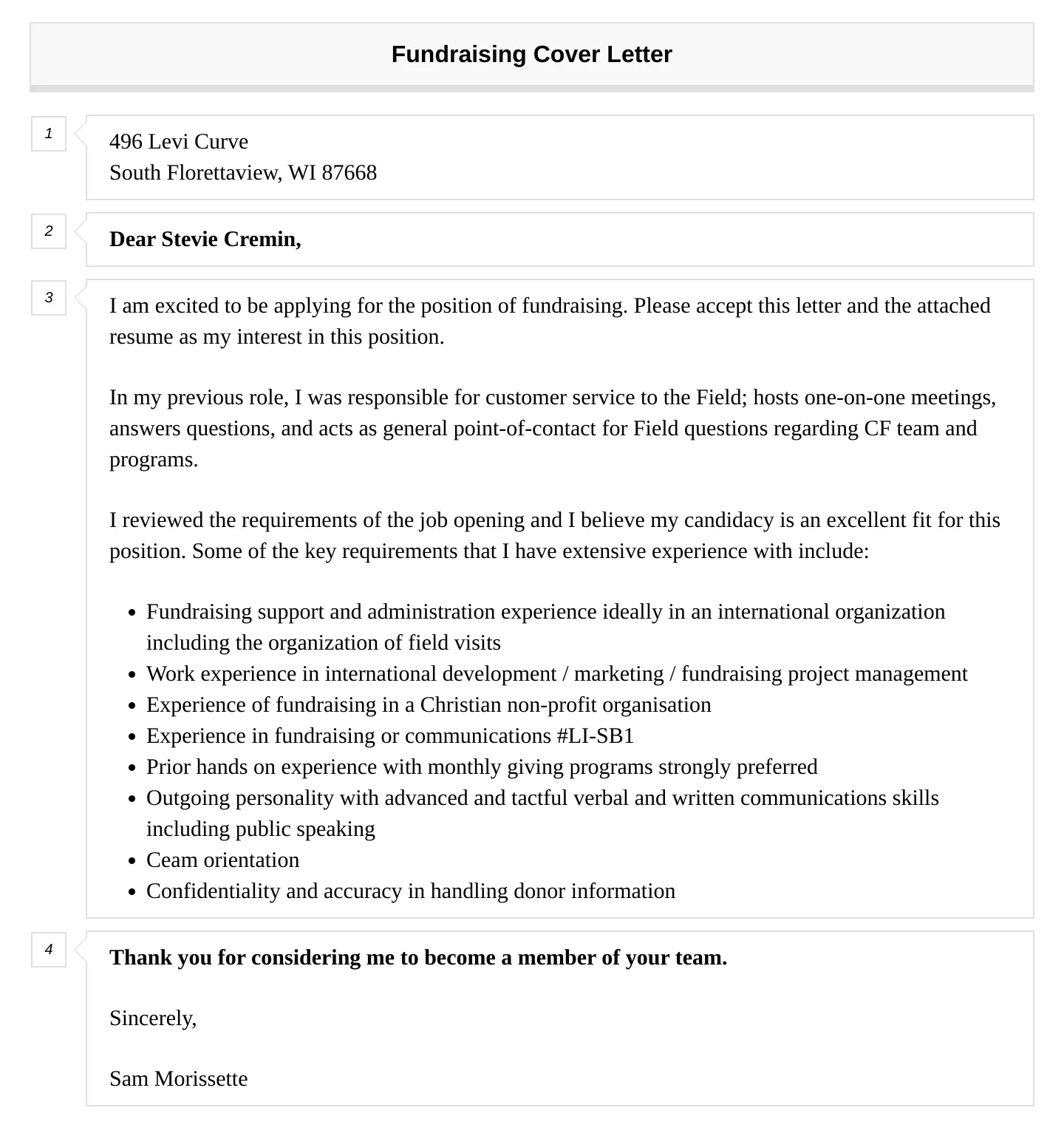
Fundraising requires a diverse skill set, and it’s vital to highlight these in your cover letter. Communication skills are paramount, encompassing both written and verbal communication to articulate the organization’s mission and engage potential donors. Strong interpersonal skills are also critical for building relationships and cultivating donor relationships. Additionally, analytical skills are needed to analyze data, track fundraising progress, and evaluate the effectiveness of campaigns. Adaptability and resilience are crucial to handle rejection and adjust to evolving fundraising strategies. Experience with fundraising software, CRM systems, and data analysis tools is highly desirable. Tailor your cover letter to highlight the skills most relevant to the specific job and organization. Consider showcasing any experience you have with grant writing, event planning, donor stewardship, or digital marketing, depending on the job requirements.
Researching the Organization
Thorough research is a cornerstone of a successful cover letter. Start by exploring the organization’s website, social media profiles, and annual reports to gain a deep understanding of its mission, values, and current fundraising initiatives. Identify their target audience, the impact they have on the community, and their recent achievements. Understanding the organization’s goals helps you tailor your cover letter to demonstrate how your skills and experience align with their needs. Look for any specific campaigns or projects mentioned in the job description and address how you can contribute to their success. Research the organization’s leadership team to understand their priorities and the organizational culture. This knowledge will not only help you write a compelling cover letter but also prepare you for potential interview questions. Demonstrate that you are genuinely interested in their work and passionate about their mission.
Showcasing Your Passion and Experience
Your cover letter is your opportunity to convey your passion for fundraising and the organization’s mission. Start by clearly stating your enthusiasm for the role and why you are interested in working for that particular organization. Share a personal story or anecdote that demonstrates your commitment to the cause or the sector. This makes your cover letter more memorable and personal. The body of your cover letter should expand on your relevant experience and skills. Use specific examples to illustrate your accomplishments and highlight how you have contributed to successful fundraising initiatives in the past. Always relate your past experiences to the job requirements outlined in the job description. Show how your skills align with the organization’s needs and how you can contribute to their fundraising goals. This helps to convey to the hiring manager your dedication to the role.
Highlighting Relevant Experience
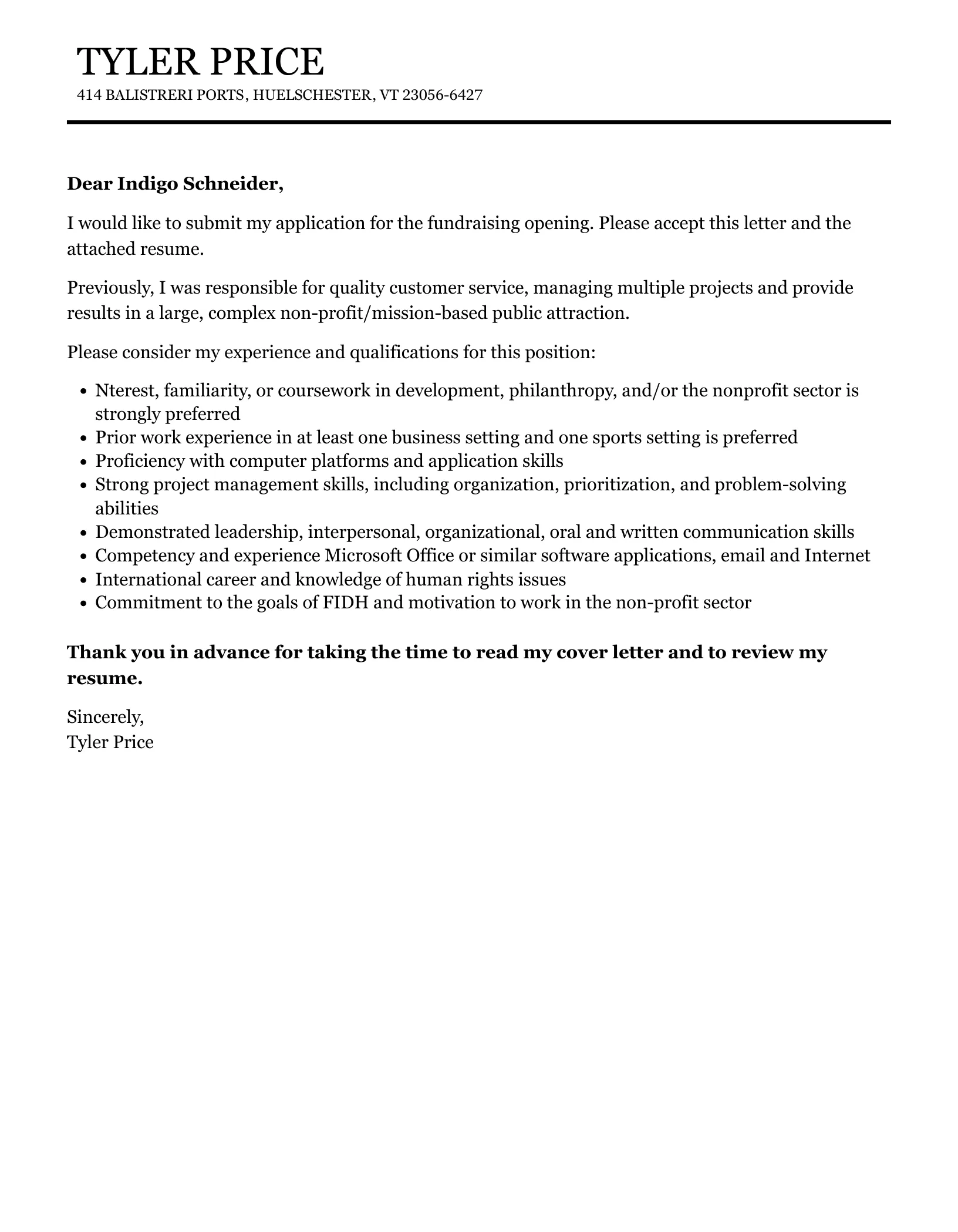
Focus on the experiences most relevant to the fundraising job you are applying for. Describe your previous roles, responsibilities, and accomplishments in detail. If you have experience in grant writing, provide examples of successful grant proposals you have written and the amounts of funding you secured. If you have experience in donor relations, describe your strategies for building and maintaining relationships with donors, including successful cultivation and stewardship efforts. Showcase your experience with fundraising events, including the planning, execution, and evaluation of these events. If you’ve worked with CRM systems or fundraising software, mention your proficiency in these tools and how you’ve used them to improve fundraising outcomes. Tailor your examples to match the requirements of the job description. Focus on the experiences that best demonstrate your ability to succeed in the role.
Quantifying Achievements
Whenever possible, quantify your achievements to demonstrate the impact you’ve made in previous roles. Use numbers and statistics to illustrate your successes. For example, instead of saying “Increased donor engagement,” say “Increased donor engagement by 20% through the implementation of a new stewardship program.” If you have experience in securing grants, mention the total amount of funding you have helped secure and the number of grants you have written. If you have organized fundraising events, mention the amount of money raised or the increase in attendance. These numbers add credibility to your claims and make your cover letter more persuasive. Quantifying your achievements provides concrete evidence of your ability to deliver results and your value to the organization. Quantifiable results also make it easier for the hiring manager to assess your capabilities and compare your application with others.
Tailoring Your Cover Letter
Generic cover letters do not work. Tailor each cover letter to the specific job and organization you are applying for. This shows that you have taken the time to research the organization and understand their needs. Review the job description carefully and identify the key skills, qualifications, and experiences that the employer is looking for. Use the job description as a guide to emphasize the relevant aspects of your background. Highlight your achievements that directly align with the job requirements. Customize the tone and style of your cover letter to match the organization’s culture. If the organization emphasizes collaboration and teamwork, highlight your ability to work effectively in a team. If the organization values innovation, emphasize your creativity and problem-solving skills. Address the hiring manager by name if possible and mention any specific programs or initiatives that resonate with you. Demonstrating this level of personalization will make your cover letter much more memorable.
Structuring Your Fundraising Job Cover Letter
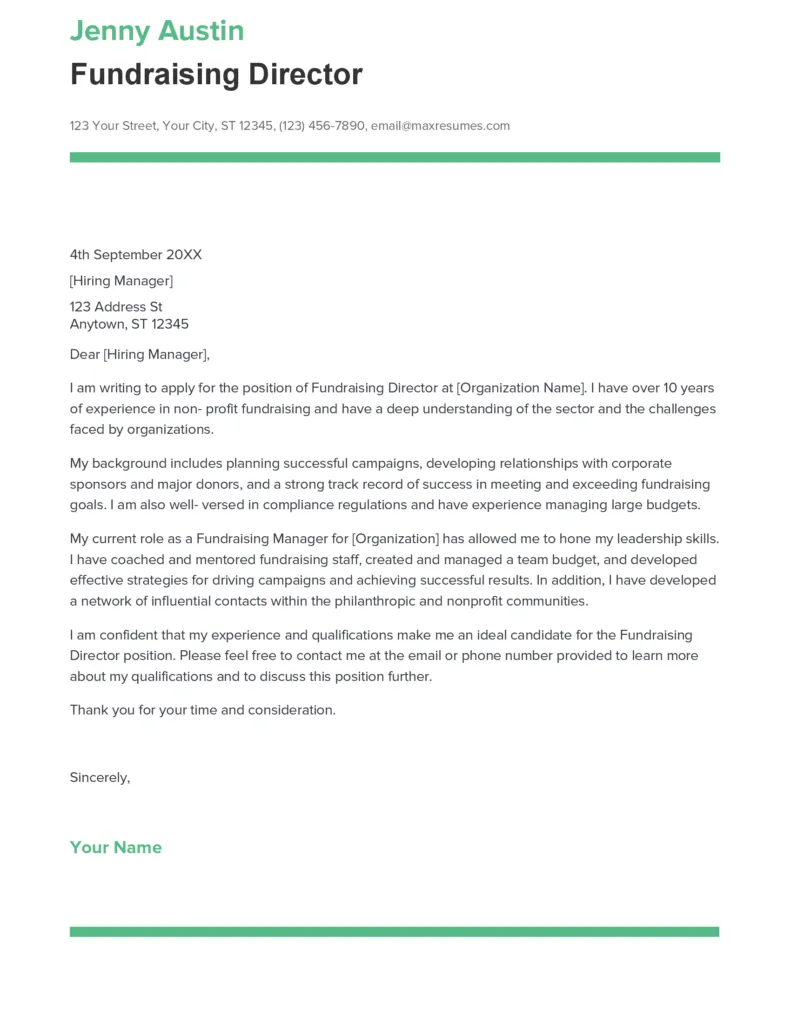
A well-structured cover letter is easy to read and highlights your key qualifications effectively. There are common elements that should be included to make the cover letter perfect. Keep the layout clean and professional and use a standard font. It is important to ensure all sections connect and flow smoothly, it is recommended to avoid unnecessary technical terms or jargon. Structure your cover letter into distinct sections: an opening paragraph, body paragraphs, and a closing paragraph. The organization should be clear to the recruiter so that all relevant information is presented quickly and clearly, helping them to fully grasp the information you have provided.
Opening Paragraph That Grabs Attention
The opening paragraph is your first chance to make a strong impression. Start with a compelling hook that captures the hiring manager’s attention. This could be a brief statement about your enthusiasm for the role, a quick summary of your relevant experience, or a personal anecdote that relates to the organization’s mission. Clearly state the position you are applying for and where you found the job posting. Briefly mention why you are interested in the organization and what specifically attracts you to their mission. This demonstrates that you have done your research and are not just sending out a generic application. Keep the opening paragraph concise and to the point. Aim to create a sense of intrigue that encourages the hiring manager to read on. Your opening needs to be powerful and personal.
Body Paragraphs Emphasizing Value
The body paragraphs are where you provide the details of your experience and skills. Use these paragraphs to showcase your qualifications, experiences, and accomplishments. Focus on the most relevant aspects of your background and align them with the job requirements. Each paragraph should have a clear topic sentence that introduces the main idea. Support your claims with specific examples and quantifiable achievements. Use the STAR method (Situation, Task, Action, Result) to describe your experiences. Elaborate on each role and the contributions you made. Your cover letter should present a narrative that highlights the value you bring to the organization. Break up large blocks of text into shorter paragraphs to improve readability. Use strong action verbs to describe your responsibilities and achievements. Provide details which will convince the reader that you are the perfect candidate.
Call to Action and Closing
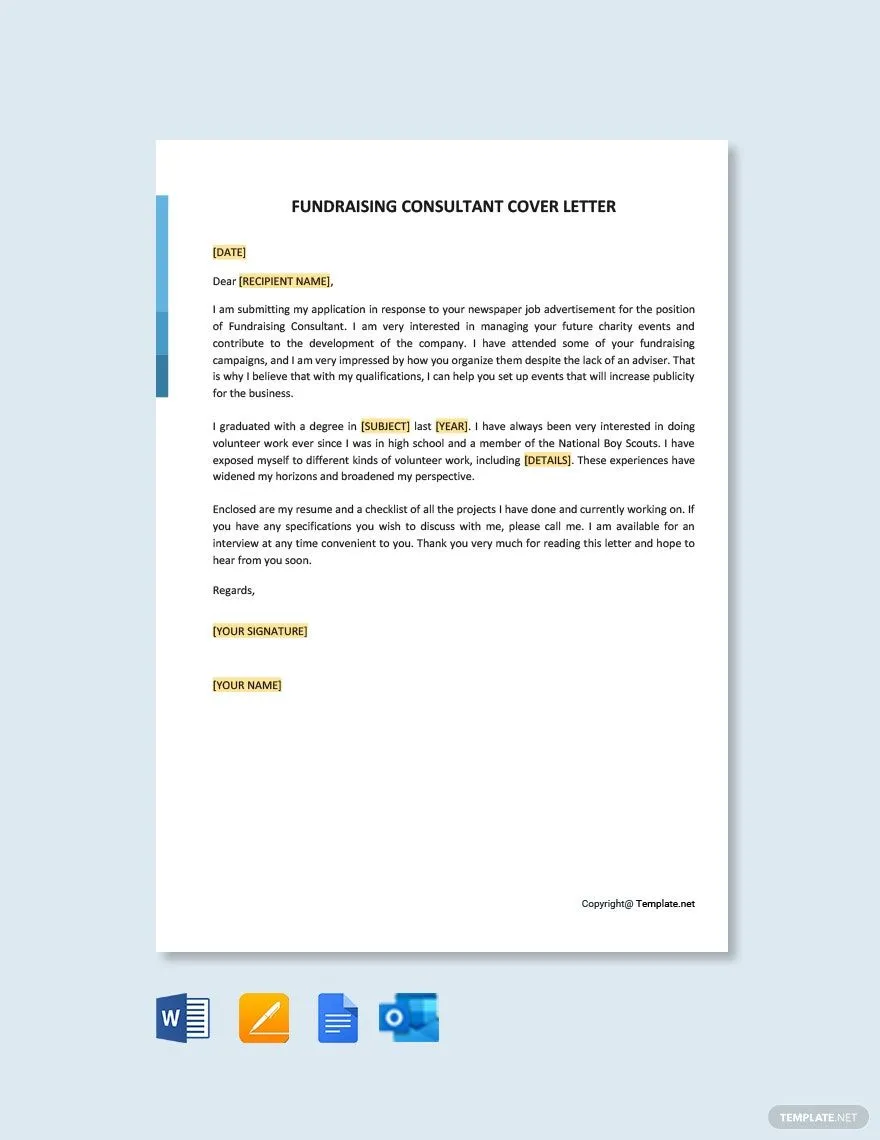
The closing paragraph should reiterate your interest in the position and the organization. Express your enthusiasm for the opportunity to learn more. Include a clear call to action, such as requesting an interview. Thank the hiring manager for their time and consideration. Include your contact information, including your phone number and email address. Make sure your closing is professional and confident. Avoid any phrases that diminish your confidence, such as “I hope to hear from you soon” or “I believe I am a good fit.” Instead, use phrases like “I am eager to discuss my qualifications further in an interview” or “I look forward to hearing from you.” Proofread your closing paragraph carefully and ensure it is free of any errors. Leave a lasting positive impression.
Proofreading and Editing Your Letter
Proofreading and editing are critical steps in the cover letter writing process. Before submitting your cover letter, thoroughly proofread it to catch any errors in grammar, spelling, punctuation, and formatting. Errors can undermine your credibility and give the impression that you are not detail-oriented. Read your cover letter aloud to catch any awkward phrasing or sentences that do not flow smoothly. Use a grammar and spell-checker tool to help identify errors, but remember that these tools are not foolproof. Review your cover letter multiple times, ideally with a fresh perspective each time. If possible, ask a friend, colleague, or career advisor to review your cover letter and provide feedback. This extra set of eyes can help identify areas for improvement that you may have overlooked. Pay special attention to the tone and style of your cover letter. Make sure it is appropriate for the organization and the position. Double-check all names, titles, and contact information. A well-proofread cover letter demonstrates professionalism and attention to detail.
Common Mistakes to Avoid
Avoid common mistakes that can weaken your cover letter. One of the most common mistakes is sending a generic cover letter that is not tailored to the specific job and organization. Generic cover letters do not demonstrate your genuine interest and commitment to the role. Avoid making grammatical errors and typos, as they can damage your credibility. Avoid using jargon, acronyms, and technical terms that the hiring manager may not understand. Avoid being overly wordy or verbose. Keep your cover letter concise and to the point, focusing on the most relevant information. Avoid including irrelevant information that does not support your qualifications. Avoid focusing too much on what you want from the job and not enough on what you can offer to the organization. Avoid using negative language or criticizing previous employers. Ensure the letter matches the style of the company.
Seeking Feedback
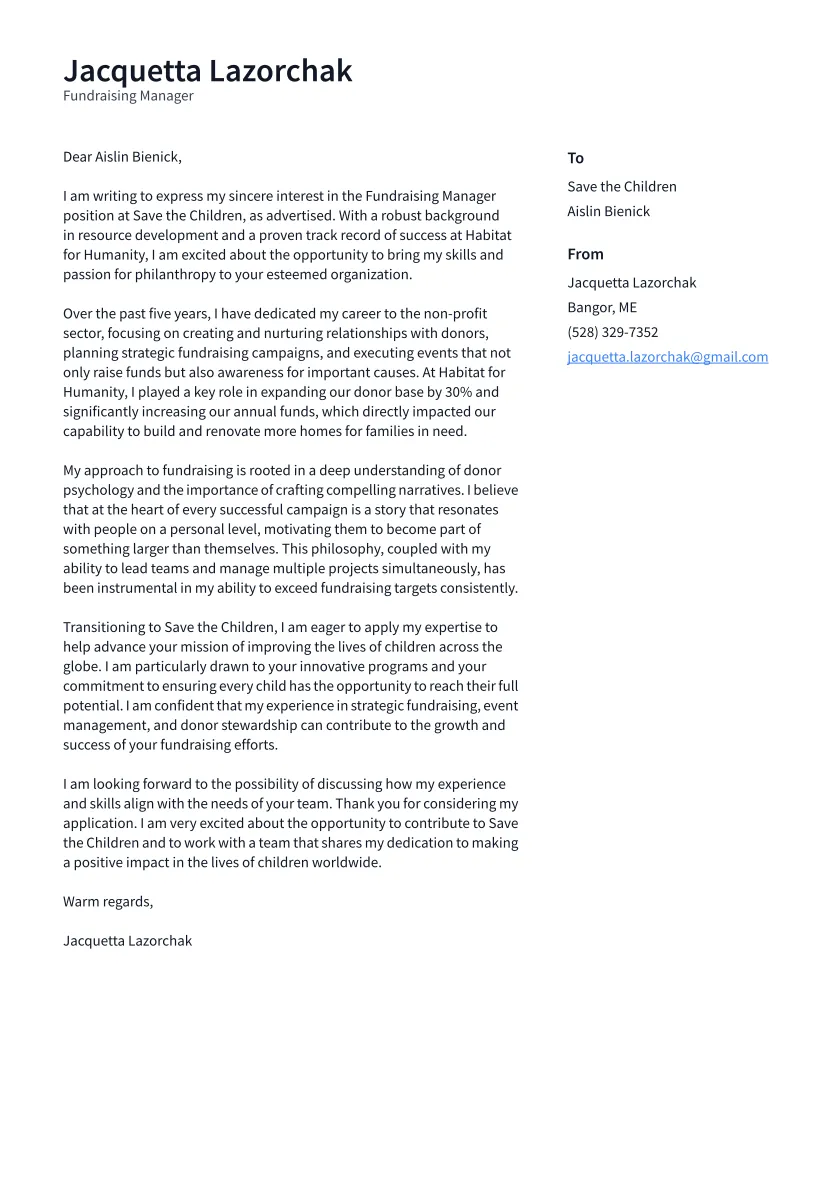
Seeking feedback from others can greatly improve your cover letter. Ask trusted friends, colleagues, or career advisors to review your cover letter and provide constructive criticism. Their feedback can help you identify areas for improvement that you may have overlooked. Request feedback on the clarity, structure, and content of your cover letter. Ask for feedback on the tone, style, and overall effectiveness of your cover letter. Be open to receiving feedback and willing to make revisions based on the suggestions. If possible, ask someone with experience in fundraising or the nonprofit sector to review your cover letter. Their insights can be particularly valuable. Use the feedback you receive to refine your cover letter and make it as strong as possible. Take feedback as a learning opportunity to improve your writing and presentation skills.
